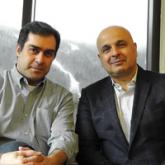Video

Cenk Ayata, MD, & Messoud Ashina, MD
Does the blood–brain barrier open during migraine? Dr. Alan Rapoport speaks with Dr. Cenk Ayata and Dr. Messoud Ashina, who take opposites sides...
STOWE, VT—Experimental evidence suggests that migraine, particularly migraine with aura, is associated with cortical spreading depression (CSD) that transiently disrupts the blood–brain barrier (BBB). For some, the question is not whether this disruption occurs, but whether it is clinically relevant. For others, even the basic premise of a CSD-mediated disruption of the BBB is suspect. At the Headache Cooperative of New England’s 28th Annual Stowe Headache Symposium, a debate between two researchers from opposing sides of this controversy indicated that there was little common ground.
“Experiments in mice suggest that CSD might open the BBB and activate pain-sensitive fibers. However, you have heard nothing about data from humans, and in fact, many migraine patients report aura symptoms without head pain,” said Messoud Ashina, MD, PhD, Director of the Human Migraine Research Unit at the Danish Headache Center in Glostrup.
On the contrary, the scientific evidence that CSD opens the BBB is “incontrovertible,” according to Cenk Ayata, MD, PhD, Director of the Neurovascular Research Unit at Massachusetts General Hospital in Charlestown. “It is not a matter of whether the BBB opens, it is a matter of magnitude,” he said. “The critical question is whether it is clinically relevant.”
This controversy is of particular current interest. Although CSD has long been suspected to mediate migraine pain, a transient opening of the BBB may greatly affect the efficacy of monoclonal antibodies in development for migraine prophylaxis and treatment. Monoclonal antibodies that target the calcitonin gene-related peptide (CGRP) have shown promise in ongoing trials, but an opportunity to target the CNS directly could improve their efficacy. Monoclonal antibodies are too large to cross the BBB without increasing the latter’s permeability.
CSD is a wave of intense neurologic depolarization that is considered the electrophysiologic substrate of migraine aura, according to Dr. Ayata. The “massive transmembrane ion and water shifts hit the cerebral vasculature during CSD like a tsunami,” he said. Citing more than two decades’ worth of research, Dr. Ayata explained that CSD is accompanied by upregulation of multiple neurotransmitters and neuromodulators that trigger large blood flow responses and disrupt cerebrovascular reflexes, such as neurovascular coupling.
Initial studies of the role of CSD and its potential for disrupting the BBB were primarily related to stroke and head trauma. Numerous studies have supported the hypothesis that CSD is the underlying mechanism of migraine aura and a putative trigger for migraine headache. The specific sequence of events leading to CSD in migraine remains unclear, but Dr. Ayata and colleagues have conducted experiments that suggest that “CSD alone, without attendant tissue injury, can produce a transient opening of the BBB.”

Does the blood–brain barrier open during migraine? Dr. Alan Rapoport speaks with Dr. Cenk Ayata and Dr. Messoud Ashina, who take opposites sides...

